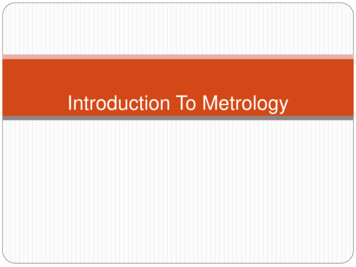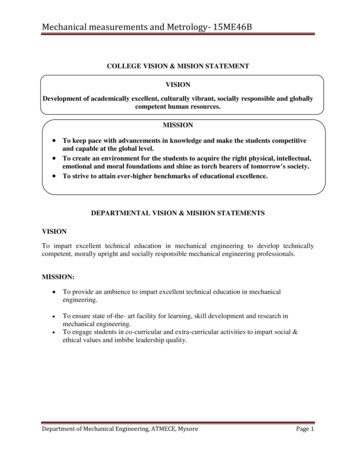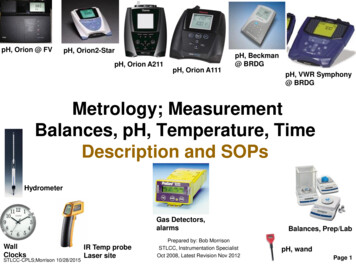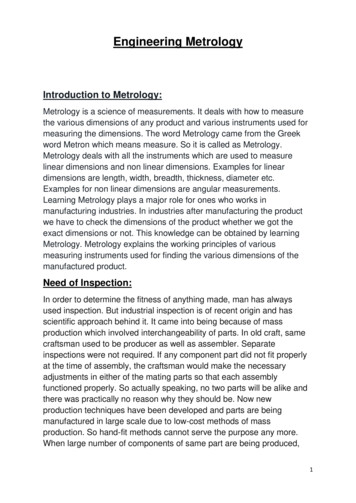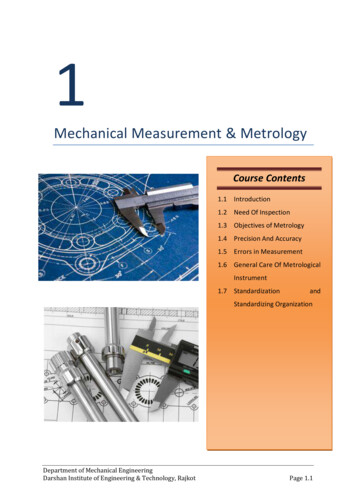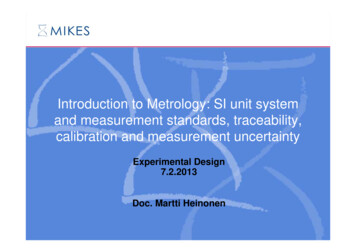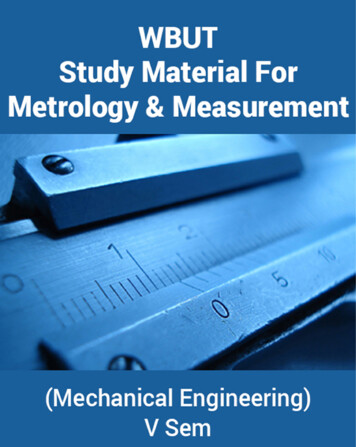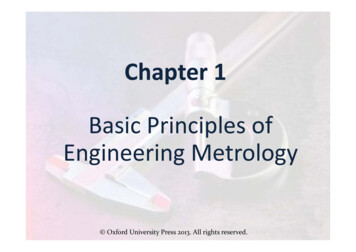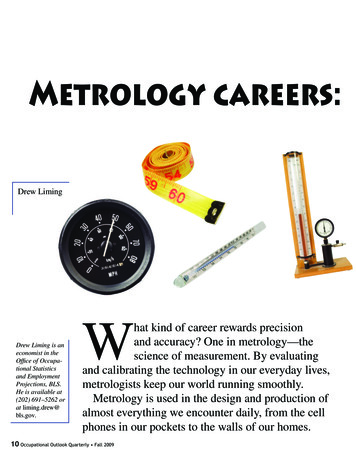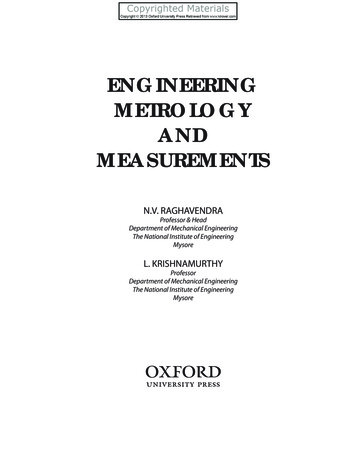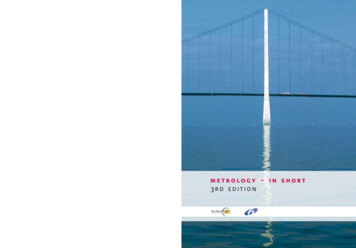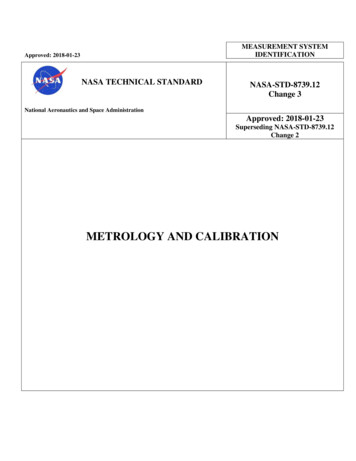
Transcription
MEASUREMENT SYSTEMIDENTIFICATIONApproved: 2018-01-23NASA TECHNICAL STANDARDNASA-STD-8739.12Change 3National Aeronautics and Space AdministrationApproved: 2018-01-23Superseding NASA-STD-8739.12Change 2METROLOGY AND CALIBRATION
NASA-STD-8739.12DOCUMENT HISTORY LOGStatusDocumentRevisionBaselineApproval DateDescription2018-01-23Initial ReleaseChange12018-03-20Added revision dates for the followingdocuments and reorganized alphabeticallyin section 2.3 under Applicable Documents:SAE AS9003, SAE AS9100, ISO 900, andJCGM 200. Deleted the followingdocuments from the Applicable Documentsand References section: ESD ADV1.0-2017and ESD Association Advisory forElectrostatic Discharge Terminology –Glossary. Moved reference documents fromAppendix A to section 2 and renamedAppendix B.Change22021-04-05Updated revision for ISO/IEC 17025 from2005 to 2017.Change32022-02-07Replaced reference to NPD 8730.5 withNPR 8735.2.2 of 10
NASA-STD-8739.123 of 10
NASA-STD-8739.12TABLE OF CONTENTSDOCUMENT HISTORY LOG . 2TABLE OF CONTENTS . 4LIST OF APPENDICES . 4LIST OF TABLES . 41.1.11.21.3SCOPE . 5Purpose. 5Applicability . 5Levying Additional or Conflicting Requirements . 52.2.12.2APPLICABLE AND REFERENCE DOCUMENTS . 5Applicable Documents . 5Reference Documents . 63.3.13.2ACRONYMS AND DEFINITIONS . 7Acronyms and Abbreviations . 7Definitions. 74.4.14.24.34.44.54.6REQUIREMENTS . 8Traceability . 8Calibration System . 8Probability of False Acceptance (PFA), Applies only to ANSI/NCSL Z540.3. 8Procurement of External Calibration Services . 9Measuring and Test Equipment Repair and Adjustment . 9Metrology and Calibration Records . 9LIST OF APPENDICESFUNCTIONS AND CONDITIONS REQUIRING CALIBRATEDMEASURING AND TEST EQUIPMENT . 10LIST OF TABLESTable 1. End-of-Period Reliability (EOPR) Values to Achieve PFA of 2% . 84 of 10
NASA-STD-8739.12METROLOGY AND CALIBRATION1.SCOPE1.1PurposeThe purpose of this NASA Technical Standard is to ensure the accuracy of measurementsaffecting safety and mission success through the proper selection, calibration, and use ofMeasuring and Test Equipment (MTE).1.2Applicability1.2.1This NASA Technical Standard is approved for use by NASA Headquarters and NASACenters, including Component Facilities and Technical and Service Support Centers, and may becited in contract, program, and other Agency documents as a technical requirement. ThisStandard may also apply to the Jet Propulsion Laboratory or to other contractors, grantrecipients, or parties to agreements to the extent specified or referenced in their contracts, grants,or agreements.1.2.2This standard is applicable to measurement applications where quantitative dataaccuracy is necessary in order to ensure safety and mission success, as identified in appendix A.1.2.3This standard does not apply where a high level of accuracy is not a consideration, suchas certain types of processes monitoring, “indication only,” or “reference only” purposes.1.3Levying Additional or Conflicting Requirements1.3.1Organization-specific calibration requirements not contained in this publication orstandards referenced herein shall be formally documented prior to implementation. The termorganization includes NASA programs and projects, NASA Centers, and NASA contractors andsubcontractors upon which this standard has been contractually invoked.1.3.2The requirement established in this NASA Technical Standard do not supersede orwaive requirements found in other Agency documents.2.APPLICABLE AND REFERENCE DOCUMENTS2.1Applicable Documents2.1.1The documents listed in this section contain provisions that constitute requirements ofthis Standard as cited in the text. Use of more recent issues of cited documents may beauthorized by the responsible Technical Authority.2.1.2The applicable documents are accessible at https://standards.nasa.gov or may beobtained directly from the Standards Developing Body or other document distributors.2.1.3Government Documents5 of 10
NASA-STD-8739.122.1.4NPR 1441.1NASA Records Management Program RequirementsNPR 8735.2Hardware Quality Assurance Program Requirements forPrograms and ProjectsNRRS 1441.1NASA Records Retention SchedulesNon-Government DocumentsANSI/NCSL Z540.1-1994 Calibration Laboratories and Measuring and Test(R2002)Equipment - General Requirements (Note: ANSI/NCSLZ540.1-1994 was withdrawn by ANSI from itsdocumentary review and revision process but remainsavailable for sale and use.)ANSI/NCSL Z540.3-2006 Requirements for the Calibration of Measuring and Test(R2013)Equipment2.2ISO/IEC 17025:2017General Requirements for the Competence of Testing andCalibration LaboratoriesANSI/ESD S20.20-2014Standard for the Development of an Electrostatic DischargeControl Program for Protection of Electrical and ElectronicParts, Assemblies and Equipment (Excluding ElectricallyInitiated Explosive Devices)SAE AS9003A (2012)Inspection and Test Quality Systems Requirements forAviation, Space and Defense OrganizationsSAE AS9100D (2016)Quality Management Systems – Requirements forAviation, Space, and Defense OrganizationsISO 9001:2015(E)Quality Management Systems – RequirementsJCGM 200:2012International Vocabulary of Metrology – Basic and GeneralConcepts and Associated Terms (VIM)Reference DocumentsThe following documents provide what is considered to be beneficial guidance and backgroundinformation, but do not constitute requirements of this standard.NASA-HDBK-8739.19-2 Measuring and Test Equipment SpecificationsNASA-HDBK-8739.19-3 Measurement Uncertainty Analysis Principles and MethodsNASA-HDBK-8739.19-4 Estimation and Evaluation of Measurement Decision Risk6 of 10
NASA-STD-8739.123.ACRONYMS AND DEFINITIONS3.1Acronyms and Abbreviations3.2ANSIAmerican National Standards InstituteEOPREnd of Period ReliabilityIECInternational Electrotechnical CommissionISOInternational Organization for StandardizationJCGMJoint Committee for Guides in MetrologyMTEMeasuring and Test EquipmentNCSLNational Conference of Standards LaboratoriesNISTNational Institute of Standards and TechnologyOEMOriginal Equipment ManufacturerPFAProbability of False AcceptanceSIInternational System of UnitsVIMInternational Vocabulary of MetrologyDefinitionsThe relevant definitions from JCGM 200, International vocabulary of metrology – Basic andgeneral concepts and associated terms (VIM), are applicable.Calibration System: The set of interrelated or interacting elements necessary tomaintain the measurement performance of measuring and test equipment to definedrequirements. (ANSI/NCSL Z540.3, Requirements for the Calibration of Measuringand Test Equipment)End of Period Reliability: The probability of an item of measuring and test equipmentbeing in tolerance at the end of its assigned calibration interval.Measuring and Test Equipment: The measuring instrument, measurement standard,reference material, or auxiliary apparatus, or a combination thereof, necessary to realizea measurement process.Note: This also includes individual items of equipment and measuring systemscomprised of several items that are used in calibration, test, inspection, andverification. (ANSI/NCSL Z540.3)7 of 10
NASA-STD-8739.124.REQUIREMENTS4.1TraceabilityMTE shall be traceable through the National Institute of Standards and Technology (NIST) or aNational Metrology Laboratory recognized by NIST to the International System of Units (SI) byan unbroken chain of calibrations.4.2Calibration System4.2.1Calibration systems shall be implemented within the context of an overarching QualityManagement System (e.g., SAE AS9100, Quality Management Systems – Requirements forAviation, Space, and Defense Organization, SAE AS9003, Inspection and Test Quality SystemsRequirements for Aviation, Space and Defense Organizations, ISO 9001, Quality ManagementSystems – Requirements), as required by NPR 8735.2, Hardware Quality Assurance ProgramRequirements for Program and Projects, applicable contracts, and agreements.4.2.2The accuracy, reliability, and use of MTE shall be controlled through the use of acalibration system compliant to one of the following standards:a. ANSI/NCSL Z540.1-1994 (R2002), Calibration Laboratories and Measuring and TestEquipment - General Requirements.b. ANSI/NCSL Z540.3-2006 (R2013).c. ISO/IEC 17025:2017, General Requirements for the Competence of Testing andCalibration Laboratories.4.2.3When calibrations compliant to ANSI/NCSL Z540.1, ANSI/NCSL Z540.3, or ISO/IEC17025 are not available, original equipment manufacturers (OEM) may provide calibrations fortheir MTE. In such cases, evidence of traceability and documented test data shall be obtainedfrom the OEM.4.3Probability of False Acceptance (PFA), Applies only to ANSI/NCSL Z540.34.3.1In cases where 20 or more like calibrations are performed (see paragraph 4.3.2 below),a probability of false acceptance (PFA) of 2% may be achieved by observing end-of-periodreliability (EOPR) values specified in the Table 1. This is considered acceptable evidence ofcompliance to ANSI/NCSL Z540.3 sub-clause 5.3.b (false acceptance requirements) and subclause 5.3.3 (measurement uncertainty requirements) for calibrations meeting these conditions.Table 1. End-of-Period Reliability (EOPR) Values to Achieve PFA of 2%Number of calibrationsLess than 2020 to 3940 to 69Required Observed EOPRNot applicable95% or greater93% or greater8 of 10
NASA-STD-8739.1270 or more92% or greater4.3.2EOPR data used to meet the 2% PFA requirement shall be for MTE of the samemanufacturer, model, and technical specifications, and result from the same calibrationprocedure and calibration interval.4.4Procurement of External Calibration Services4.4.1Procurement of calibration services, including procurements made using a purchasingcard (also known as a P-card), shall:a. Ensure that the calibration provider’s capability satisfies the range and accuracyrequirements for MTE to be calibrated.b. Specify the calibration standard which the calibration service provider is required to meetwithin the contract/subcontract/purchase order.4.5Measuring and Test Equipment Repair and Adjustment4.5.1Calibration or repair of MTE requiring direct interaction with internal or externalelectrostatic discharge (ESD) sensitive components shall be performed using ESD controls thatensure preservation of the MTE. Recommended ESD control methods are provided inANSI/ESD S20.20, Standard for the Development of an Electrostatic Discharge Control Programfor Protection of Electrical and Electronic Parts, Assemblies and Equipment (ExcludingElectrically Initiated Explosive Devices).4.6Metrology and Calibration Records4.6.1Record retention requirements for calibration records are provided in NPR 1441.1,NASA Records Management Program Requirements, and NRRS 1441.1, NASA RecordsRetention Schedule.9 of 10
NASA-STD-8739.12FUNCTIONS AND CONDITIONS REQUIRINGCALIBRATED MEASURING AND TEST EQUIPMENTA.1Testing, qualification, certification, and acceptance measurements of flight hardware,ground support equipment, test systems, or other flight-related products.A.2Measurements essential to the safety of personnel and the public or for the protection ofGovernment or private property.A.3Operation of telecommunications and transmission systems where exact signalinterfaces and circuit confirmations are essential to mission success.A.4Research and technology development, manufacturing, inspection, testing, operations,maintenance, support, or other applications where the accuracy of measurements is essential toensure safety or achieve mission success.A.5Measurements used for publishing NASA research where the conclusions and/orrecommendations of that research depend upon the quantitative accuracy of measurement results.Excluded are preliminary research papers and research instruments under development that havenot had traceable units of measurement established.A.6Physical measurements used to apportion, levy, or otherwise assign cost(s), or ensurelocal, State, or Federal regulatory compliance.Note: Calibration is not required for measurements where quantitative data accuracy isnot a consideration, including process monitoring, “indication only,” or “referenceonly” purposes.10 of 10
procedure and calibration interval. 4.4 Procurement of External Calibration Services 4.4.1 Procurement of calibration services, including procurements made using a purchasing card (also known as a P-card), shall: a. Ensure that the calibration provider's capability satisfies the range and accuracy requirements for MTE to be calibrated. b.
